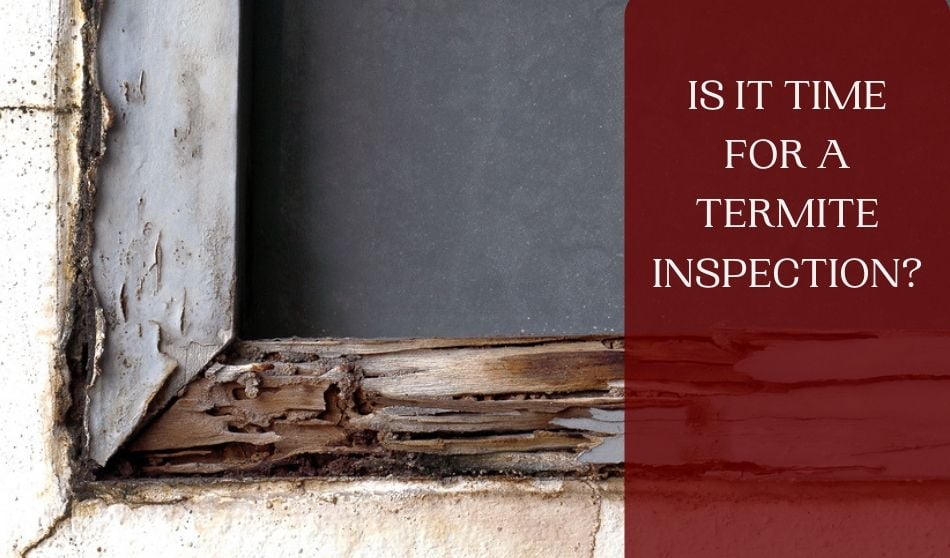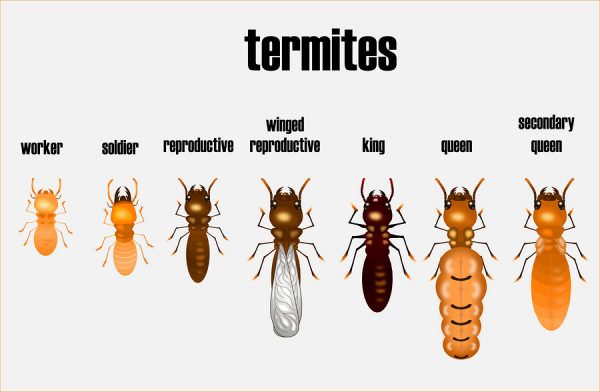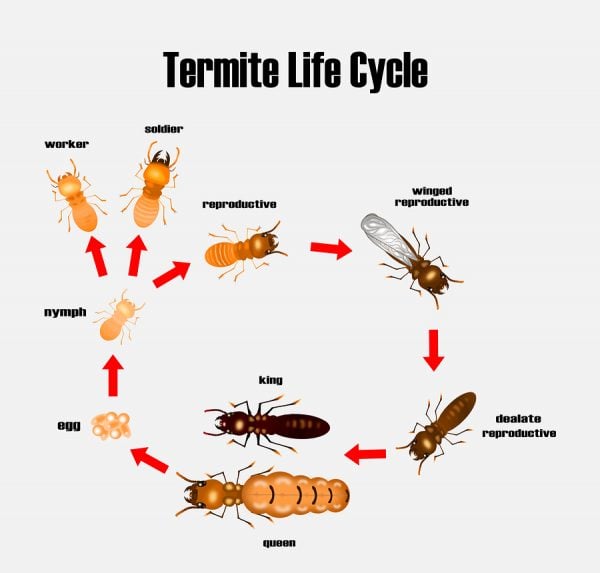
Is it time for a termite inspection? Even if you don’t see the signs, it’s recommended to have an inspection yearly but this preventative maintenance task is often overlooked. They can show up unexpected and literally eat your tenants out of house and home as well as eat through your profits.
What Do Termites Look Like?
You may be wondering what does a termite look like up close and personal. Within the colony, you will find workers, soldiers, a king, a queen, and winged reproductive swarmers depending on maturity.
Each according to their tasks, they differ in size and color. A colony can not live without a queen so eliminating her is key. A termite queen can live from 25 to 50 years and produce eggs for about 10 years making eradication an important task if termites are found in a rental property.
A quick guide to their appearance, they are straight-waisted, have fairly straight antennae, may or may not have wings depending on their maturity but when they do, the wings are similar in length. If you see them on the property, it’s time for an inspection.
There are many termite images online and a quick internet search will produce termite pictures for you to peruse. With the different roles of the colony members and different species, it might require a professional to conduct a termite inspection for specific identification.

Types of Termites
Depending on the location across the country and the conditions available there are dozens of subterranean and non-subterranean species.
Subterranean termites can be found throughout the country. Formosan termites, a type of subterranean termite makes it home mostly across the southern states.
Drywood termites and dampwood termites are encountered less frequently than their subterranean counterparts. Dampwood termites, as the name suggests, prefer coastal or humid environments and decaying timber. Pacific Coast termites are a type of dampwood species. Drywood termites prefer furniture.
Do Termites Fly?
Termites with wings are an indication that a colony matured and is ready to or has expanded to seek a new colony. These winged creatures on-the-move are called termite swarmers. The flying termites leave the home, flying mostly during the day, to find mates and form colonies of their own. Lights at night attract these swarms like a networking social event. Once established they will molt and shed their wings.
Lifecycle

What are the Signs of Termites
Long before you see any damage to the rental property, there will be signs that termites have come calling.
Wings
The big key indicator would be discarded wings. You won’t need a termite inspection to notice these laying about but if you see them, it would be a good time to schedule an appointment. If they have made your home their home, reproducing termites no longer needs their wings and will shed them as part of their life cycle.
Droppings
Some, such as the drywood termite, will leave termite droppings that appear as coarse sand piles.
Mud Tubes
They tend to create mud tubes atop concrete or cement as they make their journey across the property in search of wood to consume.
Termites
Keep your eyes open for them in the landscaping elements of the front or back yard; especially in trees and shrubs near the home.
Termite Damage
The ultimate sign is the damage they cause. Check wood in, around, and under the home that appears rotten or showing visible holes. You might also find cracked or bubbled paint in the interior.
Insects That Look Like Termites
There are a few bugs that look like termites. Although they can also cause infestation and damage, they are not as insidious.
Carpenter Ants
Carpenter ants closely resemble termites but there are a few subtle differences.
– Termites are straight-waisted whereas carpenter ants waists are pinched in.
– A colony of termites has similar wing lengths but flying ants have varied length wings.
– The antennae of ants are bent but termites antennae are straight.
– Ants do not lose their wings but termites shed their wings.
Acrobat Ants
Like the carpenter ants, the acrobat ants bodies are segmented and antennas are bent. The difference between these and the carpenter ants is that their abdomen is heart-shaped and they can bend in ways that make for an acrobatic quality.
Insects That Behave Like Termites
In addition to carpenter and acrobat ants that bore into wood, there are a few other insects that can infest. These insects behave like termites by causing damage to wood but look and act very distinct.
Powderpost Beetles
Powderpost beetles is a term that encompasses several species of insects. These are distinct in that larva bore, feeding on wood, leaving very distinct holes and piles of powder dust (sawdust) in their wake.
Carpenter Bees
Carpenter bees look distinctly like a bee so there will be no confusion if you happen to see them. What sets them apart is that they will bore holes in beams and untreated wood, but do not consume wood as does a termite or powderpost beetle.
How to Get Rid of Termites
There are chemical and non-chemical solutions for DIY termite treatments but it’s recommended to relinquish any infestation to the professionals. However, here are some suggestions that might be helpful while you research your vendor options to find a professional for a termite inspection.
Borax or Diatomaceous Earth
Applying either around or under the home, or anywhere they may travel causes dehydration and a shut-down of their nervous system. Be careful to use these with some caution, wearing a mask when applying. Do not use in areas where pets or children have access.
Orange Oil or Neem Oil
Orange or neem oil is a growth inhibitor and disrupts reproduction behavior. Both are non-toxic and relatively safe. They kill termites on contact and need to be applied repeatedly which would be difficult to accomplish in a rental property.
Kitchen Solutions
You could try some holistic solutions such as soapy water, white vinegar, cayenne pepper, and/or salt to get rid of termites. Again, this would require a considerable amount of time and attention by administering multiple applications which might be difficult to accomplish while keeping tenants happy and undisturbed. Consider trying these ideas as preventative maintenance measures during a tenant turn-over or property renovation.
Termite Prevention
The consequences of an infestation can be both time consuming and expensive. Catching these issues before they happen is the key. A good time to do that check would be during your seasonal maintenance routine.
A professional inspection might be your best defense if you are not comfortable going into crawl spaces and attics of the home. Some recommend an annual inspection where other experts suggest inspections spaced two to five years after an initial termite inspection.
A professional termite inspection on an average size home may take approximately an hour and cost around $100 a visit. You might find a vendor willing to offer seasonal or yearly inspections with preventative measures for all types of insects and bugs for a reasonable fee within your budget.
Although a professional is recommended, there are tactics you can use as a property manager or landlord to help keep infestations at bay.
Seal Cracks
Check for and fill cracks around windows and walls. Plug or seal around wires and cables where utilities enter the home.
Home Ventilation
Make sure the home is properly ventilated and precautions are in place to reduce humidity and moisture.
Landscaping
It might be a bad idea to use wood mulch around a home. Research mulch options carefully before application. A good choice would be recycled tire or other rubber made into mulch. Cedar mulch would be another option as it repels them; killing them within weeks from when they ingested.
Some trees attracted termites, especially if rotting or unkempt. Be sure to trim trees and shrubs routinely. While Sycamore trees are harmful to these insects, they are not a low maintenance landscaping option for a rental property.
Use a gravel bed or other methods to keep siding and decks away from the soil. An eighteen-inch perimeter is recommended.
Wood Features and Wood Piles
Check around wood fencing, decks, gazebos, and verandas. Most importantly, if the home features a wood-burning stove, designate an area away from any structure for housing a woodpile.
Infestations of any kind is a costly endeavor and keeping your rental property pest-free lends to protecting your investment for long-term rental use. It’s time for a termite inspection when and if the home is showing signs they are present but also seasonally during routine maintenance as well as professionally when necessary.





Hey just read the blog it is very informative as proper termites inspection is necessary to keep the termites away from the house, Thank you so much for sharing this,
You’re very welcome – glad it was useful.